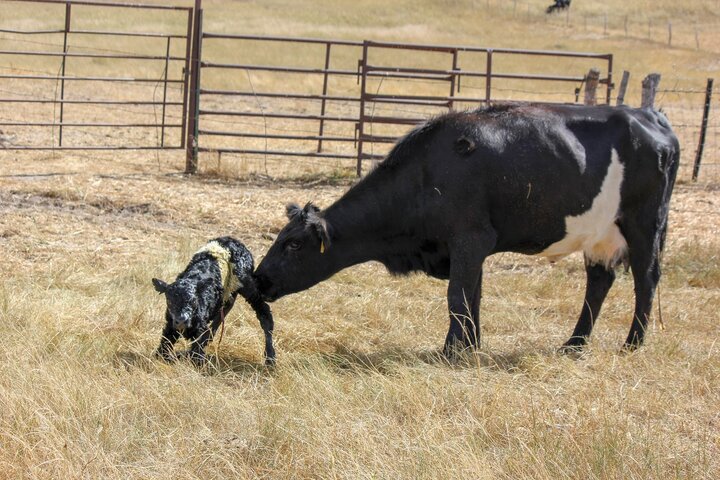Calving someone else’s cows or heifers can be a great enterprise for a beginning rancher, a method to reduce the overhead cost of facilities and equipment, and a strategy for marketing feed. Or, having someone else calve some or all of your cowherd can reduce labor and stress and allow for an operation to remain sustainable or expand if skilled seasonal labor is limited.
Having a simple and straightforward agreement in writing can be the difference between disagreement and disappointment and a satisfying experience for both parties involved.
The primary reason to have a written agreement is to have all expectations from both parties completely described and agreed upon. The process of putting thoughts on paper facilitates discussion and can force both parties to think through their expectations. This way both individuals know exactly what the other expects and there are no surprises or misunderstandings at the end of the calving season. Risks at calving can be high for the cow and calf, and many things can go wrong resulting in significant financial losses. Being on the same page is essential.
How to write a simple and accurate agreement
A basic agreement includes the names of each individual involved, the description and location of the property involved, start and end dates, payment structure and schedule, and signatures from all parties involved.
The body of the agreement includes expectations written in clear terms. This can be accomplished by having each party write their expectations in their own words, and then combining them into a single document.
Considerations for what to include in an agreement
- Who is providing feed and at what cost?
- Who is the consulting veterinarian and who pays veterinary expenses (typically the cattle owner)?
- How are calving difficulties and treatments to be handled?
- Documentation and disposal of death loss.
- How excessive death loss will be handled.
- Expected cow body condition at the transition of care, both at the start when the operator takes the cows and at the end when they go back to the owner.
- Monitoring expectations and protocols (check interval during the day and night, conditions that warrant bringing a calf into shelter or into a warmer, actions before and during inclement weather, etc.)
- Protocols and expectations at birth (tag, castrate, vaccinate, weigh, etc.) and who pays any associated expenses (tags, vaccines, etc.).
- How a difficult birth is defined if charging a fee (any assistance, using facilities, hand pull using chains, pulled using a puller, etc.)
- If and how often the owner plans to observe the cattle and how visits are to be arranged.
Considerations for determining a fair rate
The factors and rates below are only a starting point for both sides to consider. Each scenario is different, and these differences can dramatically impact the rate and the entire arrangement. In the best interest of both parties, we recommend working through the scenario and arrangement with an independent third party such as an Extension Educator or consultant.
Factors that influence a custom calving rate
- Animal Class and Age – calving heifers often requires more labor than calving running age cows
- Calving due date (January - March born calves are often significantly more work than April-May born calves)
- Bull calving EPD (is this known?)
- Protocols and expectations (tag, castrate, vaccinate, weigh, check interval, inclement weather protocol, etc.)
Baseline custom calving rates for consideration
Winter grazing on crop residue or pasture (minimal supplement or feed): $0.75-1.25/head/day plus $0.25 - $0.40/head/day care fee and supplement or feed at cost.
Winter feeding on crop residue or pasture twice per week or less: $0.25-$.50/head/day care and feed delivery fee plus supplement or feed at cost.
Custom calving: $0.50 to $0.75/head/day yardage fee (labor and equipment to feed a full ration and the use of facilities including bunks, barns, working facilities, corrals, etc.) plus feed, supplement, salt, mineral, bedding, etc. at cost.
Live calf charge/bonus: $50 to $100/head (varies depending on protocols and expectations at birth and labor requirements depending on the animal age and calving due date
Fee for assisting a difficult birth: $75 (difficult birth should be defined in the agreement).
Conclusion
Taking the time to thoroughly develop a written agreement may seem a bit daunting, but doing so will help to clearly communicate expectations for all parties involved and also reduce the risk of misunderstandings. Where appropriate, an attorney should be consulted to draft a legal agreement. The information provided in this article does not, and is not intended to, constitute legal advice. It is provided for general informational purposes only and you should not act or refrain from acting based on any information provided in this article. Please consult with your own legal counsel with respect to any particular situation or specific legal questions you may have.
Interviews with the authors of BeefWatch newsletter articles become available throughout the month of publication and are accessible at https://go.unl.edu/podcast.
Topics covered:
Marketing, budgets & management, Budgets & cost of production, Calving

